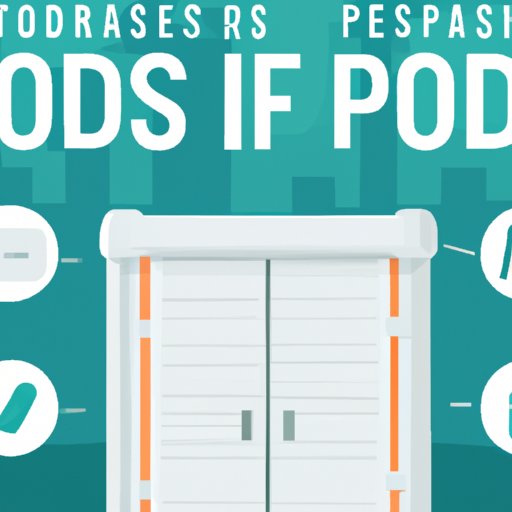Introduction
Moving can be a stressful and expensive process. When it comes to storing items during a move, many people are torn between using traditional self-storage or portable on-demand storage (PODs). Understanding the differences between these two services and analyzing the associated costs is important for making an informed decision.
Overview of PODs vs. Traditional Self-Storage
A POD is a portable storage container that can be delivered directly to your home or business. You can pack the POD at your own pace, and once you’re finished loading it up, the company will come and transport the POD to their storage facility. PODs are a great option for those who want more flexibility with their storage needs.
Traditional self-storage, on the other hand, requires you to rent a storage unit at a storage facility. You will then have to transport all of your items to the storage unit and pack them yourself. This can be a time-consuming and exhausting process.
Understanding the Different Types of PODs and Their Costs
PODs come in different sizes and prices, depending on how much space you need. The size of the POD will determine how much it will cost to rent and store. Generally, you can expect to pay anywhere from $100 to $500+ per month for a POD, depending on the size and location.
The most common sizes of PODs are 8x7x5, 8x8x12, and 8x16x8. An 8x7x5 POD is typically used for small moves, such as moving a studio apartment. An 8x8x12 POD is usually used for larger moves, such as moving a 3-4 bedroom house. And an 8x16x8 POD is typically used for very large moves, such as moving a 5+ bedroom house.
Comparing the Cost of PODs vs. Traditional Self-Storage
When comparing the cost of PODs vs. traditional self-storage, it’s important to consider the initial cost and the long-term benefits.
Initial Cost Comparison
The initial cost of PODs and traditional self-storage depends on the size of the unit and the duration of the rental period. Generally, PODs are more expensive upfront than traditional self-storage units. For example, a 10×10 traditional self-storage unit can cost around $120 for a one-month rental, while a 12×8 POD can cost around $250 for a one-month rental.
Analyzing the Long-term Benefits
When considering the long-term benefits, PODs often offer more savings. Many traditional self-storage facilities require renters to sign long-term contracts, whereas PODs often have shorter rental periods. Additionally, many POD companies offer discounts for longer rental periods. So if you plan on renting a POD for an extended period of time, you may be able to save money in the long run.

How to Cut Costs When Using a POD
If you’re looking to save money when using a POD, there are several steps you can take. First, it’s important to understand all the potential fees associated with PODs. These fees include delivery fees, pickup fees, and storage fees. Once you understand all the potential fees, you can calculate the best option for your moving needs.
For instance, some POD companies offer discounts for customers who book a certain number of days in advance. Additionally, some POD companies offer discounts for customers who book multiple PODs at once. By taking these steps, you can save money on your POD rental.
Pros and Cons of PODs and Traditional Self-Storage
When deciding between PODs and traditional self-storage, it’s important to understand the advantages and disadvantages of each.
Advantages of Using PODs
One of the main advantages of using PODs is the convenience. PODs can be delivered directly to your home or business, which saves time and energy. Additionally, PODs are often more secure than traditional self-storage units, as they are monitored 24/7 by the company.
Disadvantages of Using PODs
The main disadvantage of using PODs is the cost. As mentioned earlier, PODs tend to be more expensive upfront than traditional self-storage units. Additionally, PODs have limited space, so you may not be able to fit all of your items in one POD.
Advantages of Using Traditional Self-Storage
The main advantage of using traditional self-storage is the cost. Traditional self-storage units tend to be cheaper upfront than PODs. Additionally, traditional self-storage units are often larger than PODs, so you may be able to fit more items in one unit.
Disadvantages of Using Traditional Self-Storage
The main disadvantage of using traditional self-storage is the inconvenience. Traditional self-storage units require you to transport all of your items to the storage facility, which can be time-consuming and exhausting. Additionally, traditional self-storage units are not always as secure as PODs, as they are not monitored 24/7.
Conclusion
When deciding between using PODs or traditional self-storage for your next move, it’s important to consider the initial cost and the long-term benefits. PODs are often more expensive upfront but can offer more savings in the long run. Traditional self-storage units are usually cheaper upfront but require more effort and time to transport items to the storage facility. Ultimately, the decision should be based on your specific needs and budget.
(Note: Is this article not meeting your expectations? Do you have knowledge or insights to share? Unlock new opportunities and expand your reach by joining our authors team. Click Registration to join us and share your expertise with our readers.)
